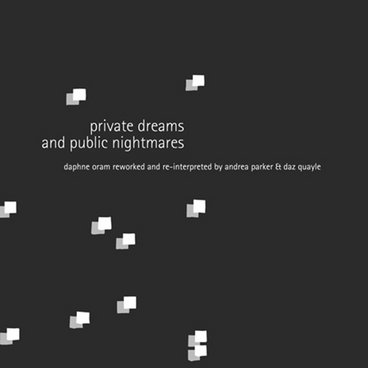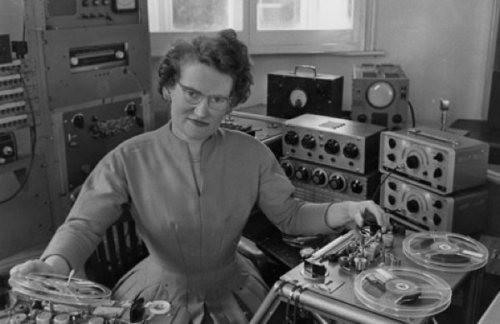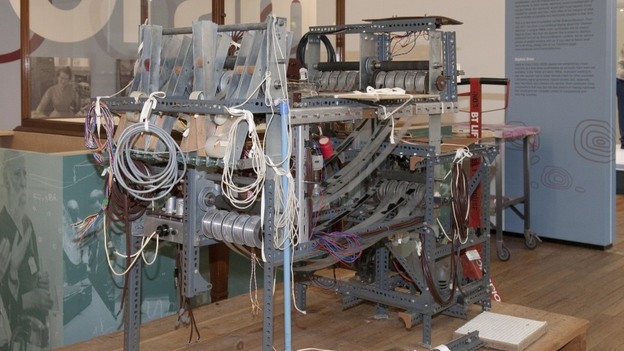Private Dreams and Public Nightmares, Daphne Oram reworked by Andrea Parker & Daz Quayle
This is could have been posted in the news department, but since the source material is from a truely remarkable and fascinating chapter in music history, Daphne Oram and the Oramics Machine and the album has the potentiality to become a milestone in electronic music, this deserves it's own thread.

- "Andrea Parker's avant-garde electronics label, Aperture, present a labour of love for Parker and co, delving into their in-depth knowledge of the life and works of electronics pioneer, Daphne Oram. Exploring a less familiar side to the BBC radiophonic workshop founder, original and un-heard compositions are reworked and reinterpreted by Parker and Daz Quayle with the intention of creating a body of material that second-guesses Oram's own moves."
- Bleep.

Daphne Oram (31 December 1925 5 January 2003) was a British composer and electronic musician. She was the creator of the "Oramics" technique for creating electronic sounds.
- "Educated at Sherborne School For Girls, Oram was, from an early age, taught piano and organ as well as musical composition.[1] In 1942 she was offered a place at the Royal College of Music but instead took up a position as a Junior Studio Engineer and "music balancer" at the BBC.[2] During this period she became aware of developments in "synthetic" sound and began experimenting with tape recorders. She also spent some time in the 1940s composing music, which remained unperformed, including an orchestal work entitled Still Point.[1] In the 1950s she was promoted to become a music studio manager and, following a trip to the RTF studios in Paris, began to campaign for the BBC to provide electronic music facilities for composing sounds and music, using electronic music and musique concrète techniques, for use in its programming.[2] In 1957 she was commissioned to compose music for the play Amphitryon 38. Using a sine wave oscillator, an early tape recorder and some self-designed filters, she produced the score from only electronic sources; the first of its kind at the BBC.[2] Along with fellow electronic musician and BBC colleague Desmond Briscoe, she began to receive commissions for many other works - including a significant production of Samuel Becketts All That Fall. As demand grew for these electronic sounds, the BBC gave Oram and Briscoe a budget to establish the BBC Radiophonic Workshop in early 1958, where she was the first Studio Manager.[2] In October of that year, she was sent by the BBC to the "Journées Internationales de Musique Expérimentale" at the Brussels Worlds Fair (where Edgard Varèse demonstrated his Poème électronique). After hearing some of the work produced by her contemporaries and being unhappy at the BBC's music department's lack of interest, she decided to resign from the BBC less than one year after the workshop was opened, hoping to develop her techniques further on her own . . ."
- Much more @ Wikipedia

- ""Forget everything you've ever known about synthesizers. This machine has no piano keyboard or anything like that. It looks like the sort of thing that a mad inventor would make in his shed."
That's how Tim Boon, chief curator of the Science Museum in London, describes a curious contraption that recently made its way into the museum's collection: the Oramics machine. Primarily made of old shelving equipment, it's about the height of a large table, with wires sprouting from every crevice and strips of paint-streaked cinema film running along the top. According to Boon, it's an ancestor of the modern synthesizer.
Daphne Oram, who died in 2003, was the machine's namesake and inventor. Boon says Oram got the idea in the late 1950s, when she was working at the BBC Radiophonic Workshop the sound-effects wing of the British broadcaster.
"For a whole decade, they had been making electronic music by recording natural sounds and splicing them together using reel-to-reel tape machines," Boon says. "It was a very difficult way of making music. That's why she set about trying to make a machine which was specifically designed to make electronic sounds."
Those film strips running through the machine determined the kind of music it would make: An operator would literally paint a design onto the film, whose patterns of light and dark could be read and interpreted as sounds. Researchers released an Oramics iPhone app earlier this year, which allows users to replicate the experience by "painting" with their fingers.
Boon says that, sadly, the app is as close as we'll get to the real thing today. The museum decided early on that, because Oram's machine is unique and irreplaceable, to try to run it would be to compromise its historic value.
"It's probably 20, 25 years since Daphne last ran it. If we were to get it running, we would have to replace a lot of the components," Boon says. "It's a bit like that thing people say: 'Here's an old hammer it's had two heads and three handles.' In what sense is that the same hammer?"
- Npr.org - October 9, 2011.
- Here's as far as I've been able to work out, at least in parts, the source material from the album @ Youtube:
Early BBC radiophonics: Private Dreams and Public Nightmares (1957).

- "Andrea Parker's avant-garde electronics label, Aperture, present a labour of love for Parker and co, delving into their in-depth knowledge of the life and works of electronics pioneer, Daphne Oram. Exploring a less familiar side to the BBC radiophonic workshop founder, original and un-heard compositions are reworked and reinterpreted by Parker and Daz Quayle with the intention of creating a body of material that second-guesses Oram's own moves."
- Bleep.

Daphne Oram (31 December 1925 5 January 2003) was a British composer and electronic musician. She was the creator of the "Oramics" technique for creating electronic sounds.
- "Educated at Sherborne School For Girls, Oram was, from an early age, taught piano and organ as well as musical composition.[1] In 1942 she was offered a place at the Royal College of Music but instead took up a position as a Junior Studio Engineer and "music balancer" at the BBC.[2] During this period she became aware of developments in "synthetic" sound and began experimenting with tape recorders. She also spent some time in the 1940s composing music, which remained unperformed, including an orchestal work entitled Still Point.[1] In the 1950s she was promoted to become a music studio manager and, following a trip to the RTF studios in Paris, began to campaign for the BBC to provide electronic music facilities for composing sounds and music, using electronic music and musique concrète techniques, for use in its programming.[2] In 1957 she was commissioned to compose music for the play Amphitryon 38. Using a sine wave oscillator, an early tape recorder and some self-designed filters, she produced the score from only electronic sources; the first of its kind at the BBC.[2] Along with fellow electronic musician and BBC colleague Desmond Briscoe, she began to receive commissions for many other works - including a significant production of Samuel Becketts All That Fall. As demand grew for these electronic sounds, the BBC gave Oram and Briscoe a budget to establish the BBC Radiophonic Workshop in early 1958, where she was the first Studio Manager.[2] In October of that year, she was sent by the BBC to the "Journées Internationales de Musique Expérimentale" at the Brussels Worlds Fair (where Edgard Varèse demonstrated his Poème électronique). After hearing some of the work produced by her contemporaries and being unhappy at the BBC's music department's lack of interest, she decided to resign from the BBC less than one year after the workshop was opened, hoping to develop her techniques further on her own . . ."
- Much more @ Wikipedia

- ""Forget everything you've ever known about synthesizers. This machine has no piano keyboard or anything like that. It looks like the sort of thing that a mad inventor would make in his shed."
That's how Tim Boon, chief curator of the Science Museum in London, describes a curious contraption that recently made its way into the museum's collection: the Oramics machine. Primarily made of old shelving equipment, it's about the height of a large table, with wires sprouting from every crevice and strips of paint-streaked cinema film running along the top. According to Boon, it's an ancestor of the modern synthesizer.
Daphne Oram, who died in 2003, was the machine's namesake and inventor. Boon says Oram got the idea in the late 1950s, when she was working at the BBC Radiophonic Workshop the sound-effects wing of the British broadcaster.
"For a whole decade, they had been making electronic music by recording natural sounds and splicing them together using reel-to-reel tape machines," Boon says. "It was a very difficult way of making music. That's why she set about trying to make a machine which was specifically designed to make electronic sounds."
Those film strips running through the machine determined the kind of music it would make: An operator would literally paint a design onto the film, whose patterns of light and dark could be read and interpreted as sounds. Researchers released an Oramics iPhone app earlier this year, which allows users to replicate the experience by "painting" with their fingers.
Boon says that, sadly, the app is as close as we'll get to the real thing today. The museum decided early on that, because Oram's machine is unique and irreplaceable, to try to run it would be to compromise its historic value.
"It's probably 20, 25 years since Daphne last ran it. If we were to get it running, we would have to replace a lot of the components," Boon says. "It's a bit like that thing people say: 'Here's an old hammer it's had two heads and three handles.' In what sense is that the same hammer?"
- Npr.org - October 9, 2011.
- Here's as far as I've been able to work out, at least in parts, the source material from the album @ Youtube:
Early BBC radiophonics: Private Dreams and Public Nightmares (1957).

Comments
Vicki Bennett aka People Like Us who, as some might remember, has colaborated with Ergo Phizmiz on the Perpetuum Mobile album, is responsible for this:
People Like Us - Reworking Daphne Oram
- "In January 2005, Sonic Arts Network, the leading UK body for electronic music and sound art, was asked by Daphnes descendants to care for her collected papers, recordings and other items. It was with the benefit of experimental electronic music practice in mind that Goldsmiths Electronic Music Studio (EMS) collaborated with the Sonic Arts Network (SAN) to bring this collection into the academic community where it could be properly studied and developed. To this end, a grant was awarded to Goldsmiths, University of London in 2007 by the Arts and Humanities Research Council, to catalogue the collection, digitise the audio tapes and initiate related research.
In June 2008 People Like Us were invited into the archives of electronic music pioneer Daphne Oram, to rework them into new compositions, to be presented as part of a day-long symposium at London's South Bank Centre. Here are the results."
- " Since 1991 Vicki Bennett has been making CDs, radio, and A/V multimedia under the name People Like Us. By animating and recontextualising found footage collages Vicki gives an equally witty and dark view of popular culture with a surrealistic edge. People Like Us broadcasts an ongoing experimental arts radio and podcast show on WFMU, called "DO or DIY", which, since it began in 2003, has had over a million "listen again" downloads.
Vicki has shown work at, amongst others, Tate Modern, The National Film Theatre, Purcell Room, The ICA, Sydney Opera House, Pompidou Centre, Sonar in Barcelona, The Walker Art Center in Minneapolis, The Barbican, Maxxi in Rome, the BBC and Channel 4. She has also performed radio sessions for the BBC's John Peel, Mixing It, and also CBC, KPFA and many more in the US. There have been features in The Observer, The Wire, NME and BBC website. People Like Us have been commissioned by The Arts Council England, The BBC, AV Festival, Sonic Arts Network, Forma, LUX and Lovebytes amongst others.
The almost entire People Like Us back catalogue is also available for free download, which has been generously hosted by UbuWeb in conjunction with PennSound, and also WFMU. PLU has been released on labels such as Illegal Art, Tigerbeat6, Soleilmoon, Sonic Arts Network, Touch and For Us Records (Rough Trade), both solo, and also collaborating with Matmos, Ergo Phizmiz, Wobbly and Christian Marclay.
Vicki had her first solo London show "The Doors of Perspection" at Vitrine Gallery in Bermondsey Square in July-September 2011.
A new People Like Us CD "Welcome Abroad" was released in May 2011 on Illegal Art. People Like Us have just completed a new live a/v set "The Magical Misery Tour" commissioned by Sound and Music, premiered at The Sound Of Fear at London's Southbank Centre in September 2011."
- http://peoplelikeus.org/
Ilse focuses on experimentation, improvisation, electronics and the avant-garde" and is run by Travis Johnson:
In The Ether: Daphne Oram Remixed
released 20 June 2012.
- "All pieces use electronic sounds created by Daphne Oram in the 1960s, with kind permission from The Science Museum."